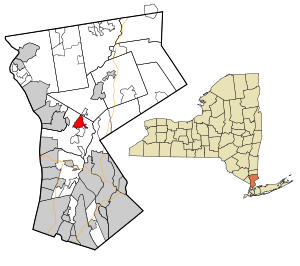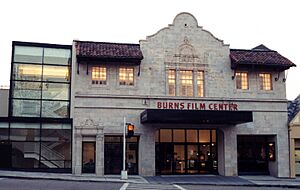Pleasantville, New York facts for kids
Quick facts for kids
Pleasantville, New York
|
|||
|---|---|---|---|

Gazebo near train station
|
|||
|
|||

Location within Westchester County and state of New York
|
|||
| Country | United States | ||
| State | New York | ||
| County | Westchester | ||
| Town | Mount Pleasant | ||
| Settled | 1695 | ||
| Incorporated | 1897 | ||
| Area | |||
| • Total | 1.85 sq mi (4.80 km2) | ||
| • Land | 1.85 sq mi (4.80 km2) | ||
| • Water | 0.00 sq mi (0.01 km2) | ||
| Elevation | 292 ft (89 m) | ||
| Population
(2020)
|
|||
| • Total | 7,513 | ||
| • Density | 4,061/sq mi (1,565.2/km2) | ||
| Time zone | UTC−5 (EST) | ||
| • Summer (DST) | UTC−4 (EDT) | ||
| ZIP Code |
10570-10572
|
||
| Area code | 914 | ||
| FIPS code | 36-58728 | ||
| GNIS ID | 96074 | ||
Pleasantville is a small village in Westchester County, New York, United States. It is about 30 miles north of Manhattan. In 2020, 7,513 people lived there.
Pleasantville is home to a campus of Pace University. It also has the Jacob Burns Film Center, a popular movie theater. Most students in Pleasantville attend schools in the Pleasantville Union Free School District. This includes Bedford Road School, Pleasantville Middle School, and Pleasantville High School.
Contents
History of Pleasantville
Early Beginnings: Native Americans and Settlers
The area where Pleasantville is now was first home to the Rechgawawank and Sinsink tribes. These tribes were part of the Lenni Lenape people. They lived here after the last ice age. The Lenape were known for managing the land and farming. They also hunted and gathered food.
The Lenape were peaceful and good at solving problems between tribes. They had trade routes that went through what is now Pleasantville. By the late 1600s, many Lenape people had died from diseases or conflicts. Others were forced to move west. Today, Lenape people live in places like Ontario, Oklahoma, and New Jersey.
In 1695, a French settler named Isaac See came to the area. He worked for a Dutch landowner. This was the start of modern settlement in Pleasantville.
The American Revolution and a New Name
By the time of the American Revolution, the settlement had English, Dutch, and Quakers. Most of them were farmers. During the war, this area was called the "Neutral Ground." People living here had different ideas about who to support.
A British spy named Major John André passed through Pleasantville. He was carrying secret information from Benedict Arnold. André got lost and was captured nearby. His capture was a big moment that helped the American forces win the war.
In the early 1800s, the settlement was called Clark's Corners. This was named after Henry Clark, who owned land there. The main business area was at Broadway and Bedford Road. In 1828, a new post office was planned. The postmaster, Henry Romer, suggested the name Clarksville. But another New York town already had that name. His second choice, Pleasantville, was accepted. The Pleasantville Post Office opened on February 29, 1828.
The Railroad Arrives
A major change for Pleasantville happened in 1846. The New York Central Railroad arrived. A train station was built the next year. This caused the village's main business area to move to its current spot. The old business district is now called the Old Village.
The railroad made travel to New York City much faster. It took only 70 minutes by train. Before, it was a five-hour trip by stagecoach. The current train station was built in 1905. It was moved in the 1950s to make way for new tracks.
Pleasantville was also a stop on the Underground Railroad. This was a secret network of safe houses. Escaped slaves from the South used it to find freedom in the North.
Growth and Modernization
The late 1800s saw fast growth in Pleasantville. By the 1870s, there were many small businesses. These included shoemaking, shirtmaking, and a pickle factory. The first newspaper, The Pleasantville Pioneer, started around 1886.
Many small farms were divided into lots for new homes. These were built for a growing middle class. In the 1890s, a police department, volunteer fire department, and library system were started. Pleasantville officially became a village on March 16, 1897.
In the early 1900s, Pleasantville became a modern suburb. Many people commuted to New York City by train. Roads were paved, water pipes were installed, and electricity came to homes. Other improvements included parks and fields. By World War II, the village looked much like it does today.
Cultural Highlights
Pleasantville has a rich history with writers and artists. Playwright Lillian Hellman lived on Hardscrabble Farm in the 1940s and 1950s. Author Dashiell Hammett also lived and worked there.
DeWitt Wallace and Lila Bell Wallace started Reader's Digest in Pleasantville in 1922. They used a converted garage as their first office. Later, they built a larger office. Reader's Digest moved its main office in 1939. But it kept its Pleasantville post office box. This made the village's name known to millions of readers worldwide.
In 2001, the Jacob Burns Film Center opened. It is in the old Rome Theater building. This center shows independent and world films. Famous guests like Jerry Lewis and Stephen King have visited.
Pleasantville is also home to the Westchester Table Tennis Center. Many people train there, some hoping to become Olympic athletes. The village also hosts the Pleasantville Music Festival. This is an all-day outdoor event in July. It features many bands and artists.
The Pleasantville Farmers Market started in 1998. It is now the largest year-round farmers market in Westchester County. It attracts thousands of people each week.
From 1975 to 1987, the New York Giants football team held their training camp at Pace University. Thousands of fans would visit. This helped local businesses.
Pleasantville is also special because it hosted a royal wedding. This was between Estelle Bernadotte and Folke Bernadotte, a Swedish count.
The Marmaduke Forster House is an important historical building. It was added to the National Register of Historic Places in 2011.
Geography
Pleasantville is a small village. It covers about 1.8 square miles (4.8 square kilometers) of land.
Population and People
| Historical population | |||
|---|---|---|---|
| Census | Pop. | %± | |
| 1900 | 1,204 | — | |
| 1910 | 2,207 | 83.3% | |
| 1920 | 3,590 | 62.7% | |
| 1930 | 4,540 | 26.5% | |
| 1940 | 4,454 | −1.9% | |
| 1950 | 4,861 | 9.1% | |
| 1960 | 5,877 | 20.9% | |
| 1970 | 7,110 | 21.0% | |
| 1980 | 6,749 | −5.1% | |
| 1990 | 6,592 | −2.3% | |
| 2000 | 7,172 | 8.8% | |
| 2010 | 7,019 | −2.1% | |
| 2020 | 7,513 | 7.0% | |
| U.S. Decennial Census | |||
In 2000, there were 7,172 people living in Pleasantville. There were 2,637 households. About 35% of households had children under 18. The average household had about 2.6 people.
The population was spread out by age. About 28.5% were under 18. About 13.3% were 65 or older. The average age was 38 years.
Education
Most students in Pleasantville attend schools in the Pleasantville Union Free School District. Some parts of the village are in the Mount Pleasant Central School District.
Notable People
- John Emory Andrus, politician
- Matt Ballinger, singer
- Dave Barry, humorist, author
- Estelle Bernadotte, Swedish countess
- Louis Biancaniello, music producer
- Nick Catalano, author
- Benjamin Cheever, author
- Chips, a famous war dog from World War II
- Anne Hyde Choate, Girl Scout leader
- Johnny Craig, comic book artist
- Will Englund, journalist
- Edward Gelsthorpe, marketing executive
- Terry George, Irish screenwriter and director
- Paul Geroski, economist
- Bill Graham, rock music promoter
- Dashiell Hammett, author
- David G. Hartwell, science fiction editor
- Lillian Hellman, playwright
- Otis Hill, professional basketball player
- Douglas Kennedy, journalist
- Morgana King, singer and actress
- Boris Koutzen, violinist and composer
- Brandon Larracuente, actor
- Norman Leyden, musician and composer
- Kyle Lowder, actor
- Gavin MacLeod, actor
- Sean Maher, actor
- Aaron Maine, musician
- Janet Maslin, film critic
- Seabury C. Mastic, lawyer and politician
- Kurt McKinney, actor
- Scott Mebus, author and composer
- John Nonna, Olympic fencer
- Stephen O'Leary, soccer player
- Scott Perlman, baseball player
- George Petitpas, human resource expert
- Sidney Poitier, actor
- Steven Clark Rockefeller
- Deion Sanders, football coach and NFL Hall of Famer
- David Selby, actor, producer, writer
- Will Shortz, puzzle creator for the New York Times
- Henry Stone, record label owner
- Robert Tagliapietra, fashion designer
- DeWitt Wallace, co-founder of Reader's Digest
- Lila Bell Wallace, co-founder of Reader's Digest
- Mark Ambor, singer-songwriter
Images for kids
See also
 In Spanish: Pleasantville (Nueva York) para niños
In Spanish: Pleasantville (Nueva York) para niños




